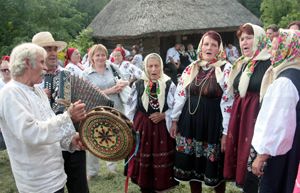Baking bread and celebrating wedding
Pyrohiv National Museum of Folk Architecture and Everyday Life hosts international ethnic fest
Zhnyva 2011-Vesillia (2011 Harvest Home, Weddings. – Ed.) is the title of the largest ethnic festival held this summer in Ukraine. Needless to say, young people were the most enthusiastic participants. What supplemented the festive atmosphere was the presence of guests from abroad. They were invited by their Ukrainian friends to share the authentic national spirit. This was the second such festival at Pyrohiv. The youngest participants were especially impressed by folk art master classes. Everyone took home a souvenir such as a rag doll made during the classes or a Hromivka traditional toy. The weather was just perfect for the occasion.
On Saturday night, VV frontman Oleh Skrypka organized an ethnic discotheque for the guests and acted as a DJ. The guests enjoyed the performance of the French rock group Red Cardell (they sang with the Ukrainian Hurtopravtsi), Trigon (Moldova), Usein Bekirov Trio (Crimea), and Vizerunchasti pisni (Kyiv). Weddings songs were performed by the Toporchestra, Szigony (Hungary), PKS (Poland), and Dzherela (Ukraine).
Those present could witness the way Harvest Home had been celebrated centuries back in the Ukrainian countryside, they could learn the right way to thresh grain, make flour using old millstones, and bake bread in the oven.
This years’ festival organizer, a nonprofit organization known as the EtnoToloka Creative Studio, invited the guests to a traditional Ukrainian wedding with all the attendant rites and ceremonies, dramatized by Sumy students who major in ethnic music.
Four months prior to the festival date a competition for the best couple was announced through social networks. This couple would have to ce-lebrate their wedding in accordance with the old-fashioned genuine Ukrainian tradition. The first to apply were Dmytro from Bila Tserkva and Daryna from Sumy. On Sunday they were wed at St. Michael’s Church, an ancient Cossack temple in Pyrohiv. The wedding festivities reflected the folk rites in Left- and Right-Bank Ukraine.
Iryna, maid of honor, says: “Each year our students undergo practical training in the Ukrainian countryside and we have noticed that each village, even if located a short way from another one, has its own way of celebrating Harvest Home and weddings. The ceremony of the bride bidding farewell to her friends is the most intimate, closing scene of the wedding festivities. It symbolizes the bride’s transformation into a young married woman, her parting with the joys of carefree maiDen’s life.”
“Too bad young people today do not want to have their weddings that way, because this is our genuine Ukrainian tradition. In my home village the weddings were celebrated the old way even during the war [i.e., WW II. – Ed.]. They could not have acted otherwise because the most important thing about the wedding is not a festively laid table. It is a celebration of true love, accompanied by folk songs and dances. During those years of poverty, compared to the present day – the years of my youth – we treasured every festive occasion,” says Halyna Kadyliak who spent most of her life in Kyiv but who, as she advanced in years, decided to return to her native village in Makariv raion, Kyiv oblast.
The festival organizers informed that this year a record wedding korovai round loaf had been baked.
“My daughter is in Spain. She got married there and sent me a video. As a mother, I was pained to watch the ceremony on the television screen. Here, during this genuine wedding ritual, I remembered the biggest mistake my daughter had made during her wedding. Instead of korovai they cut a huge lavishly decorated wedding cake. The Ukrainian korovai, decorated with the viltse wedding tree, is a symbol of fertility, family and tribal unity and integrity, health and well-being,” says Iryna Soroka, guest from Lviv oblast.
There was a traditional quest for the bride’s garland and the bridegroom’s flower hidden in the field. Those who found them would become best man and maid of honor. Here and there makeshift podiums featured kobza and lira players, troisti muzyky with their fiery dancing tunes to which one could dance right then and there. Those who felt tired could sit by campfires or take a ride in a cart. One could buy a variety of toys and souvenirs made by craftsmen. Part of the program was an exhibit of rural household antiquities, master classes in blacksmithing, wickerwork, pottery, needlework, Easter eggs painting, and so on. The Kobzar Stage practically never stayed empty. Many people visited Katrusia’s Movie Theater where they watched films on ethnic themes.
One could learn a lot of interesting things listening to the lectures on folk art, history of the Ukrainian costume, traditional Ukrainian songs and music, history of Ukrainian book printing.






